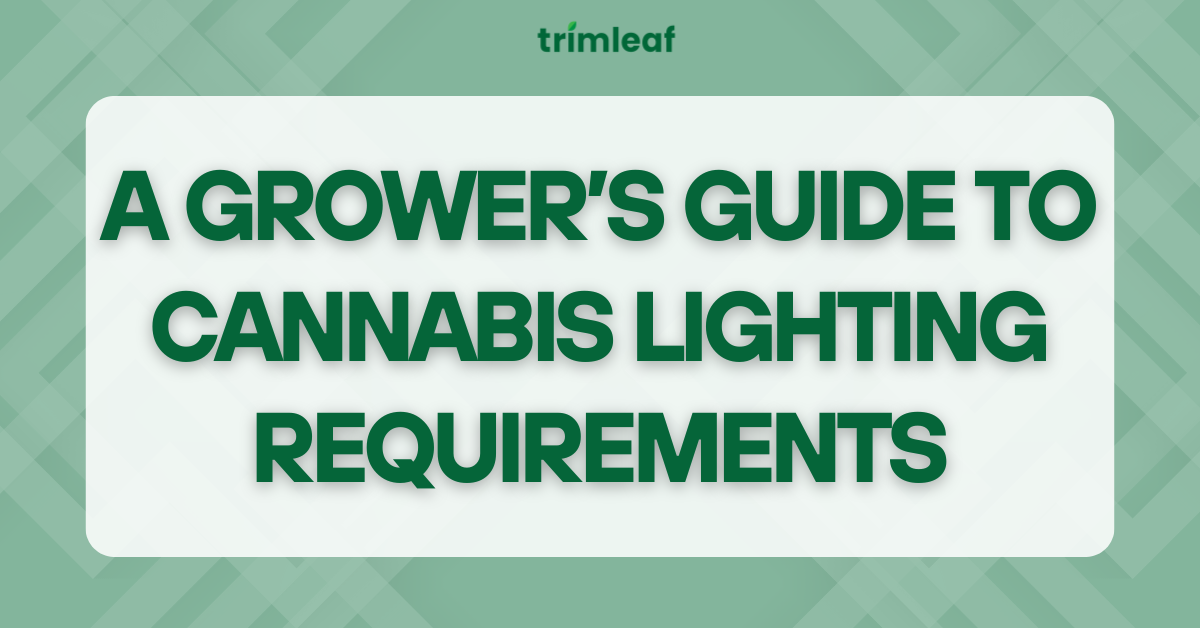
When it comes to growing cannabis, lighting isn’t just important—it’s everything. Whether you're a first-time home grower or a seasoned cultivator, understanding how much light your cannabis plant needs at each stage of growth is critical to producing healthy, resin-rich buds. In this guide, we’ll break down the lighting needs of cannabis from seedling to harvest, and help you choose the right grow light setup for your indoor grow.
Table of Contents
- Why Lighting Is Important for Cannabis Cultivation
- Light Intensity & Spectrum: What Every Grower Needs to Know
- Understanding Cannabis Lighting Requirements by Growth Stage
- Light Schedules: Matching Light to Growth
- Best Types of Grow Lights for Cannabis
- Lighting Mistakes to Avoid
- Final Thoughts: Giving Cannabis the Right Light to Grow Big
- Frequently Asked Questions About Cannabis Lighting Requirements
Why Lighting Is Important for Cannabis Cultivation
Light is the fuel behind photosynthesis, the process that drives plant growth. Without proper lighting, your cannabis plants won't reach their full potential. In fact, lighting is so important for cannabis that even slight variations in intensity, spectrum, or light schedule can dramatically impact yield and potency.
Every growth stage of a cannabis plant has specific lighting needs. From the delicate seedling phase to the flowering stage, tailoring the light you give can be the difference between a weak harvest and a thriving grow.
Light Intensity & Spectrum: What Every Grower Needs to Know
Your plant needs a specific light spectrum for each growth stage. The daily light integral (DLI) and light intensity both influence how well your cannabis plants thrive.
Use a light meter or light meter app to measure the PPFD in your grow space. Cannabis plants need consistent PPFD levels depending on the growth stage, and too much light can lead to light stress.
Blue light promotes compact growth, strong stems, and lush leaves. It's essential during the seedling and vegetative stages when your plant is building its structure. Most full-spectrum LEDs already provide sufficient blue light, but ensuring proper intensity is key.
Red light encourages bud development, stem elongation, and overall flowering performance. It mimics the sunlight of late summer and fall, triggering your plant’s reproductive phase. Most grow lights increase red output during the 12/12 light cycle.
Often overlooked, far-red light helps stretch plants in early flower and improve flower initiation timing. Many advanced LED grow lights include far-red diodes to accelerate and optimize blooming.
Understanding Cannabis Lighting Requirements by Growth Stage
Light Schedules: Matching Light to Growth
Understanding how the amount of light and darkness affects your cannabis plants is key. Here's a breakdown of common light cycles:
- 18 hours of light / 6 hours dark — Best for vegetative stage
- 12 hour light / 12 hour dark — Triggers flowering
- 24 hours of light — Sometimes used for seedlings
Autoflowering cannabis doesn’t follow typical light cycles and can flower under 18-20 hours of light. But even autoflowers benefit from a consistent light schedule tailored to each growth stage.
Quick Reference: Cannabis Lighting by Growth Stage
| Growth Stage | PPFD Range | Light Schedule |
|---|---|---|
| Seedling | 100–300 PPFD | 18 hours light / 6 hours dark |
| Vegetative | 400–600 PPFD | 18 hours light / 6 hours dark (or 24/0 optional) |
| Flowering | 800–1000 PPFD | 12 hours light / 12 hours dark |
Best Types of Grow Lights for Cannabis
LED Grow Lights
LED grow lights for cannabis are incredibly popular due to their energy efficiency, low heat output, and ability to deliver full-spectrum light. Many led grow lights are designed specifically for cannabis cultivation, offering red, blue, UV, and far-red diodes to support different light requirements throughout the grow.
HID Lighting
HID lights (like HPS and MH) are powerful and affordable, but they run hot. While they provide intense light, indoor growers often need extra ventilation to offset the heat. They're suitable for both veg and flower stages if managed properly.
Fluorescent and CFLs
These are great for seedlings and young cannabis plants but lack the intensity needed for full flowering. They're often used as supplemental light in a grow room.
Lighting Mistakes to Avoid
- Too little or too much light: Cannabis plants need the right amount of light to avoid stretching or burning.
- Ignoring the light cycle: Giving cannabis less than 12 hours a day during flowering can stall bud development.
- Bad light placement: Keep lights at the right height to ensure even light per canopy.
Indoor cannabis growers should also avoid relying on just one light. Light kits and modular systems provide more flexibility and coverage.
Final Thoughts: Giving Cannabis the Right Light to Grow Big
Lighting is one of the most important factors for cannabis growers. Whether you're growing cannabis at home or managing a commercial grow room, knowing how much light your plant needs and when is essential. Use the right light fixture, follow a proven light schedule, and adjust intensity throughout the grow cycle.
Know that cannabis is light-hungry and thrives when its lighting needs are met. From 13 hours of light in early veg to at least 12 hours to start flowering, every detail matters. A well-lit cannabis plant grows faster, produces bigger buds, and rewards you with a successful harvest.
Choose your led lighting solutions wisely, monitor light energy, and give your plants enough light throughout the grow. With the proper setup, you won’t just grow marijuana—you’ll grow it right.
Frequently Asked Questions About Cannabis Lighting Requirements
- ◄What type of light is best for growing cannabis indoors?
- Full-spectrum LED grow lights are the most efficient and versatile option for indoor cannabis cultivation. They offer energy savings, low heat output, and the right mix of blue, red, and far-red wavelengths to support all stages of plant growth.
- ◄How many hours of light do cannabis plants need?
- Cannabis plants need 18 hours of light during the vegetative stage and 12 hours of light during flowering. Autoflowering strains can flower with up to 20 hours of light but still benefit from a consistent schedule.
- ◄What is PPFD and why does it matter for cannabis?
- PPFD (Photosynthetic Photon Flux Density) measures the amount of light usable by plants. Cannabis plants need 100–300 PPFD in the seedling stage, 400–600 in veg, and 800–1000 in flower for healthy growth and high yields.
- ◄Can I use regular household lights for cannabis growing?
- No. Standard bulbs lack the correct light spectrum and intensity. You need grow lights specifically designed for plant photosynthesis, such as LEDs, HPS, or fluorescents.
- ◄How far should grow lights be from cannabis plants?
- Distance depends on the light type and power. For LEDs, keep lights 24–30 inches above seedlings and 12–24 inches above mature plants. Always monitor for signs of light burn or stretching.
- ◄Should I use different lights for different growth stages?
- Yes. Blue light is ideal for vegetative growth, while red and far-red light stimulate flowering. Many grow lights now offer adjustable spectrums or full-spectrum output to support all stages.
- ◄What happens if cannabis doesn’t get enough light?
- Plants will stretch, weaken, and produce small or airy buds. Low light intensity also reduces resin production and delays flowering.
- ◄Can too much light harm cannabis plants?
- Yes. Overexposure causes light stress, bleaching, and heat-related issues. Use a light meter to monitor PPFD levels and adjust distance or intensity as needed.
- ◄Do autoflowering strains need different lighting schedules?
- Autoflowers don’t rely on light cycles to flower. They can thrive under 18–20 hours of light from seed to harvest, but still benefit from spectrum and intensity adjustments during flowering.
- ◄How do I choose the best LED grow light for my grow space?
- Consider your grow area size, plant count, light output (PPFD/DLI), power consumption, and spectrum range. Look for lights with proven performance in cannabis grows and sufficient coverage for your tent or room.







